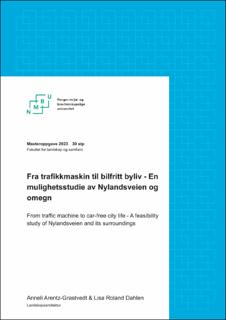| dc.contributor.advisor | Kathrine Omnia Strøm | |
| dc.contributor.author | Dahlen, Lisa Roland | |
| dc.contributor.author | Arentz-Grastvedt, Anneli | |
| dc.date.accessioned | 2023-07-26T16:27:20Z | |
| dc.date.available | 2023-07-26T16:27:20Z | |
| dc.date.issued | 2023 | |
| dc.identifier | no.nmbu:wiseflow:6839561:54592131 | |
| dc.identifier.uri | https://hdl.handle.net/11250/3081493 | |
| dc.description.abstract | Det overordnede temaet for denne masteroppgaven er transformasjon fra bilbasert til bilfritt byliv. Prosjektområdet er derfor Nylandsveien og omegn i Oslo, da dette området er svært bilbasert i dag. Designtenkning er brukt som metode for å komme opp med et forslag til hvordan området kan se ut om det transformeres fra bilbasert til å være tilrettelagt for bilfritt byliv. Prosjekteringsdelen er inndelt i to faser. I fase 1 fokuserte vi på hva vi gjør med Nylandsveien, mens vi i fase 2 jobbet med utforming av byrommene.
I dag jobbes det med å transformere bilbaserte områder til fordel for byliv og fremkommelighet for gående og syklende. Nylandsveien, en gammel rest av trafikkmaskinen som inkluderte Bispelokket, er et tydelig symbol på bilen som første prioritet. Analysene viser at hovedandelen av våre kartlagte svakheter, og brukernes mislikte områder, kan sentreres rundt brudelen av denne firefelts veien. Det gir grunnlag for at brua og nærliggende byrom har behov for et løft.
Selv om vi vil at området skal få et løft, er det viktig å bevare stedets identitet. Et av våre funn gjennom overordnede analyser var at området i seg selv, og omkringliggende steder som Bjørvika og Günerløkka, har alle ulike kvaliteter og identiteter. Grønlands kvaliteter som lokalbutikker og Akerselva med tilhørende grøntområder bør bevares og løftes frem for å beholde dets identitet.
Basert på funnene fra analyser og evalueringer av ulike løsninger, kom vi frem til at vi ønsker å rive Nylandsbrua gjennom Grønland og transformere området til torg, plasser og park. Noen av bruas stolper ønsker vi å bevare som et historisk symbol. Videre foreslår vi å omgjøre dagens bru over Oslo S til en grønn bru for gående og syklende med en perrongdel med koblinger ned til Oslo S. | |
| dc.description.abstract | The overall theme for this master's thesis is a transformation from an environment designed for cars, to an environment without cars. The project area is Nylandsveien and the surrounding area, located in Oslo, as it is highly trafficated today. Design thinking is used as a method to come up with a proposal for how the area might look if it is transformed from an area designed for cars to a car-free environment. The planning and design part is divided into two phases. In phase 1, we elaborate on our suggestions on how we can improve Nylandsveien, and in phase 2 we worked on the redesign of the surrounding area.
Generally today it is more focus on creating areas for pedestrians and cyclists then to promote car traffic. Earlier, Nylandsveien included the roundabout Bispelokket, and it was quite the traffic machine. It was a clear symbol of the car as the first priority.The biggest weaknesses, found in the analyzes, is centered around the bridge of this four-lane road. The area is also most disliked by its users. Which can be used as arguments that the bridge and the surrounding areas need an upgrade. Although we want the area to get an upgrade, preserving the place's identity is important.
Some of our findings through the overall analysis was that the area itself, and surrounding places such as Bjørvika and Grünerløkka, all have different qualities and identities. Grønland with its local shops and Akerselva with associated green areas should be preserved and promoted to retain its identity.
Based on the findings from analyses and evaluations of different solutions, we concluded that it would be best to remove Nylandsbrua that goes through Grønland, and transform the area into a place with squares and parks. We wish to preserve some of the bridge's poles as a historical symbol. Furthermore, we suggest converting the current bridge over Oslo S into a green bridge for pedestrians and cyclists, with a platform section with connections down to Oslo S.
Based on the findings from analyses and evaluations of different solutions, we concluded that it would be best to remove Nylandsbrua that goes through Grønland, and transform the area into a place with squares and parks. We wish to preserve some of the bridge's poles as a historical symbol. Furthermore, we suggest converting the current bridge over Oslo S into a green bridge for pedestrians and cyclists, with a platform section with connections down to Oslo S. | |
| dc.language | nob | |
| dc.publisher | Norwegian University of Life Sciences | |
| dc.title | Fra trafikkmaskin til bilfritt byliv - En mulighetsstudie av Nylandsveien og omegn | |
| dc.type | Master thesis | |
